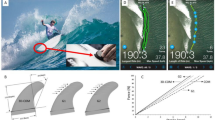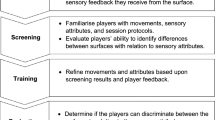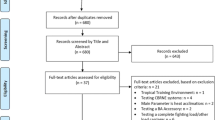Abstract
Growth in the surfing equipment industry has led to increased scientific interest in this area, yet no current paper has reviewed and synthesized the effects of equipment design on surfing. Therefore, the aims of this study were to: (1) assess the volume and type of scientific literature that is available to the authors specific to surfing equipment and design, (2) summarise all surfing equipment and design studies completed to date specific to outcome measures and key findings and (3) identify knowledge gaps in the topic of surfing equipment design. This review was conducted in accordance with the PRISMA scoping review guidelines. A total of seven electronic databases were searched (PubMed, Embase, CINAHL, SPORTDiscus, Web of Science, SCOPUS, and Ovid). Google Scholar was also searched for grey literature. Inclusion criteria were mention of surfing equipment and relevant surfing outcome measures (physiological and mechanical). Exclusion criteria were no full text availability and works not available in English. Results from these articles were then extracted, summarised and presented. A total of 17 articles were selected for review and organized by theme of board, wetsuit and fin. Fin and wetsuit design were the most prominent themes (seven studies each respectively). Most were written within the past 5 years and written in the USA. Fin design studies were largely computational, whereas board and wetsuit design were mostly field and laboratory based. Within each study theme there were consistencies in outcome measures and measuring devices. Board design studies focused on paddling efficiency (VO2 and HR). Wetsuit design studies primarily assessed thermoregulation, and less so muscle activation and paddling biomechanics. Fin design studies focused on fin shape and configuration to assess lift and drag properties. Three key themes of board, wetsuit and fin design were noted; from this the authors were able to identify several knowledge gaps such as a lack of standardisation in equipment controls and study design procedures. Alongside improving standardisation, the use of wave pools presents as an area of interest in future research.



Similar content being viewed by others
Availability of data and material
All data tables are available as Online Resources.
Code availability
Not applicable.
References
Stark A (2013) Surfing Australia: annual report 2013. Surfing Australia, Coolangatta
Warshaw M (2010) The history of surfing. Chronicle Books, San Francisco
Finney BR, Houston JD (1996) Surfing: a history of the ancient Hawaiian sport. Pomegranate, Rohnert Park
Oggiano L (2017) Numerical comparison between a modern surfboard and an Alaia Board using computational fluid dynamics (CFD). In: Proceedings of the 5th international congress on sport sciences research and technology support, Funchal, Madeira, Portugal, 2017. icSPORTS, pp 75–82. https://doi.org/10.5220/0006488400750082
Oggiano L, in het Panhuis M (2020) Modern surfboards and their structural characterization: towards an engineering approach. In: 13th conference of the International Sports Engineering Association, Online, vol 1, p 65. https://doi.org/10.3390/proceedings2020049065
Nessler J, Silvas M, Carpenter S, Newcomer S (2015) Wearing a wetsuit alters upper extremity motion during simulated surfboard paddling. PLoS One 10(11):e0142325. https://doi.org/10.1371/journal.pone.0142325
Stranger M (2010) Surface and substructure: beneath surfing’s commodified surface. Sports Soc 13(7–8):1117–1134. https://doi.org/10.1080/17430431003780054
Towner N, Lemarié J (2020) Localism at New Zealand surfing destinations: Durkheim and the social structure of communities. J Sport Tour 24(2):93–110. https://doi.org/10.1080/14775085.2020.1777186
Kampion D (2007) Greg Noll: the art of the surfboard. Gibbs Smith, Layton
Moran K, Webber J (2013) Surfing injuries requiring first aid in New Zealand, 2007–2012. Int J Aquat Res Educ 7(3):3. https://doi.org/10.25035/ijare.07.03.03
Gibson C, Warren A (2014) Making surfboards: emergence of a trans-Pacific cultural industry. J Pac Hist 49(1):1–25. https://doi.org/10.1080/00223344.2013.858439
McArthur K, Jorgensen D, Climstein M, Furness J (2020) Epidemiology of acute injuries in surfing: type, location, mechanism, severity, and incidence: a systematic review. Sports 8(2):25. https://doi.org/10.3390/sports8020025
Audy J (2007) Trends and challenges in sport science and engineering related technology education at surf science and technology: researching surfboard making activity. Eurasia J Math Sci Technol Educ 3(4):371–382. https://doi.org/10.12973/ejmste/75416
Sakellariou K, Rana ZA, Jenkins KW (2017) Optimisation of the surfboard fin shape using computational fluid dynamics and genetic algorithms. Proc Inst Mech Eng Part P J Sports Eng Technol 231(4):344–354. https://doi.org/10.1177/1754337117704538
Gudimetla P, Kelson N, El-Atm B (2009) Analysis of the hydrodynamic performance of three- and four-fin surfboards using computational fluid dynamics. Aust J Mech Eng 7(1):61–68. https://doi.org/10.1080/14484846.2009.11464579
Shormann D, Oggiano L, in het Panhuis M (2020) Numerical CFD investigation of shortboard surfing: fin design vs. cutback turn performance. In: Proceedings of the 13th conference of the International Sports Engineering Association, Online, vol 1, p 132. https://doi.org/10.3390/proceedings2020049132
Oggiano L, Pierella F (2018) CFD for surfboards: comparison between three different designs in static and maneuvering conditions. In: 12th conference of the International Sports Engineering Association, Brisbane, Queensland, Australia, vol 6, p 309. https://doi.org/10.3390/proceedings2060309
Shormann DE, in het Panhuis M (2020) Performance evaluation of humpback whale-inspired shortboard surfing fins based on ocean wave fieldwork. PLoS One 15(4):e0232035. https://doi.org/10.1371/journal.pone.0232035
MacNeill MS (2015) Bio-inspired optimal fin shape and angle for maximum surfboard stability. Masters thesis, Michigan Technological University, Digital Commons @ Michigan Tech
Farley OR, Harris NK, Kilding AE (2012) Physiological demands of competitive surfing. J Strength Cond Res 26(7):1887–1896. https://doi.org/10.1519/JSC.0b013e3182392c4b
Farley ORL (2011) Competitive surfing: a physiological profile of athletes and determinants of performance. Masters thesis, Auckland University of Technology, Tuwhera Open Access Theses & Dissertations
Mendez-Villanueva A, Bishop D (2005) Physiological aspects of surfboard riding performance. Sports Med 35(1):55–70. https://doi.org/10.2165/00007256-200535010-00005
Ekmecic V, Jia N, Cleveland TG, Saulino M, Nessler JA, Crocker GH, Newcomer SC (2017) Increasing surfboard volume reduces energy expenditure during paddling. Ergonomics 60(9):1255–1260. https://doi.org/10.1080/00140139.2016.1261188
Furness JW, Hing WA, Sheppard JM, Newcomer SC, Schram BL, Climstein M (2018) Physiological profile of male competitive and recreational surfers. J Strength Cond Res 32(2):372–378. https://doi.org/10.1519/JSC.0000000000001623
Agnelli C, Mercer JA (2018) Muscle activity during dryland swimming while wearing a triathlon wetsuit. Int J Kinesiol Sports Sci 6(1):7–11. https://doi.org/10.7575/aiac.ijkss.v.6n.1p.7
Agnelli CJ (2017) Upper Extremity Muscle Activity During Simulated Dryland Swimming While Wearing Wetsuit. Masters thesis, University of Nevada, Las Vegas, UNLV Theses, Dissertations, Professional Papers, and Capstones
Gay A, López-Contreras G, Fernandes RJ, Arellano R (2020) Is swimmers’ performance influenced by wetsuit use? Int J Sports Physiol Perform 15(1):46–51. https://doi.org/10.1123/ijspp.2018-0891
Hue O, Benavente H, Chollet D (2003) The effect of wet suit use by triathletes: an analysis of the different phases of arm movement. J Sports Sci 21(12):1025–1030. https://doi.org/10.1080/0264041031000140419
Prado A (2014) The wetsuit effect: physiological response to wearing a wetsuit. Masters thesis, University of Nevada, Las Vegas, UNLV Theses, Dissertations, Professional Papers, and Capstones
Prado A, Dufek J, Navalta J, Lough N, Mercer J (2017) A first look into the influence of triathlon wetsuit on resting blood pressure and heart rate variability. Biol Sport 34(1):77. https://doi.org/10.5114/biolsport.2017.63737
Ulsamer S, Rüst CA, Rosemann T, Lepers R, Knechtle B (2014) Swimming performances in long distance open-water events with and without wetsuit. BMC Sports Sci Med Rehabil 6(1):20. https://doi.org/10.1186/2052-1847-6-20
Wu J (2011) Development and design of performance swimwear. In: Pan N, Sun G (eds) Functional textiles for improved performance, protection and health. Woodhead Publishing, Elsevier, pp 226–248. https://doi.org/10.1533/9780857092878.226
Corona LJ, Simmons GH, Nessler JA, Newcomer SC (2018) Characterisation of regional skin temperatures in recreational surfers wearing a 2-mm wetsuit. Ergonomics 61(5):729–735. https://doi.org/10.1080/00140139.2017.1387291
Smith C, Saulino M, Luong K, Simmons M, Nessler JA, Newcomer SC (2020) Effect of wetsuit outer surface material on thermoregulation during surfing. Sports Eng 23(1):1–8. https://doi.org/10.1007/s12283-020-00329-8
Warner ME, Nessler JA, Newcomer SC (2019) Skin temperatures in females wearing a 2 mm wetsuit during surfing. Sports 7(6):145. https://doi.org/10.3390/sports7060145
Naebe M, Robins N, Wang X, Collins P (2013) Assessment of performance properties of wetsuits. Proc Inst Mech Eng Part P J Sports Eng Technol 227(4):255–264. https://doi.org/10.1177/1754337113481967
Tricco AC, Lillie E, Zarin W, O’Brien KK, Colquhoun H, Levac D, Moher D, Peters MD, Horsley T, Weeks L (2018) PRISMA extension for scoping reviews (PRISMA-ScR): checklist and explanation. Ann Intern Med 169(7):467–473. https://doi.org/10.7326/M18-0850
Peters MD, Marnie C, Tricco AC, Pollock D, Munn Z, Alexander L, McInerney P, Godfrey CM, Khalil H (2020) Updated methodological guidance for the conduct of scoping reviews. JBI Evid Synth 18(10):2119–2126. https://doi.org/10.11124/JBIES-20-00167
Clark JM, Sanders S, Carter M, Honeyman D, Cleo G, Auld Y, Booth D, Condron P, Dalais C, Bateup S (2020) Improving the translation of search strategies using the Polyglot Search Translator: a randomized controlled trial. J Med Libr Assoc 108(2):195. https://doi.org/10.5195/jmla.2020.834
Canadian Agency for Drugs Technologies in Health (2019) Grey matters: a practical tool for searching health-related grey literature. https://www.cadth.ca/resources/finding-evidence/grey-matters. Accessed 29 Sept 2020
Nessler JA, Frazee T, Newcomer SC (2018) The effect of foil on paddling efficiency in a short surfboard. Sports Eng 21(1):11–19. https://doi.org/10.1007/s12283-017-0240-3
Nessler JA, Hastings T, Greer K, Newcomer SC (2017) Wearing an inflatable vest alters muscle activation and trunk angle while paddling a surfboard. J Appl Biomech 33(4):282–287. https://doi.org/10.1123/jab.2016-0248
Falk S, Kniesburges S, Janka R, Grosso R, Becker S, Semmler M, Döllinger M (2019) Computational hydrodynamics of a typical 3-fin surfboard setup. J Fluid Struct 90:297–314. https://doi.org/10.1016/j.jfluidstructs.2019.07.006
Kellogg D, Wiles T, Nessler JA, Newcomer SC (2020) Impact of velcro cuff closure on forearm skin temperature in surfers wearing a 2mm and 3mm wetsuit. Int J Exerc Sci 13(6):1574–1582
Falk S, Kniesburges S, Janka R, O’Keefe T, Grosso R, Döllinger M (2020) Numerical investigation of the hydrodynamics of changing fin positions within a 4-fin surfboard configuration. Appl Sci (Switzerland). https://doi.org/10.3390/app10030816
Eliopoulos GM, Harris AD, Bradham DD, Baumgarten M, Zuckerman IH, Fink JC, Perencevich EN (2004) The use and interpretation of quasi-experimental studies in infectious diseases. Clin Infect Dis 38(11):1586–1591. https://doi.org/10.1086/420936
Glasziou P, Heneghan C (2009) A spotter’s guide to study designs. Evid Based Nurs 12(3):71–72. https://doi.org/10.1136/ebn.12.3.71
Carroll N (1989) Third fin’s the charm. The amazing-but-true story of the three-fin thruster- and how big Simon Anderson’s humble invention radically changed the face of performance surfing… forever. Surfing 25(2):78–82 (91–95)
Kampion D (1982) Surfer of the year. For Australia’s Simon Anderson, three fins were the charm. Surfing 18(5):66–73
Bain R, Hawk S (1988) Design 88: new materials, big game weaponry and dulling the cutting edge: the buzz on surfboard design in 1988 centers on these topics as epoxy gains strength, guns go off and safety makes an impact. Surfing 24(2):54–61 (126-127)
Gillogly B, George S, Carroll N (1989) Shapers: a family tree. Surfing 25(2):106–108
Pérez GM, Cobo CC (2020) Surfing Scientific output indexed in the web of science and scopus (1967–2017). Movimento 26:e26015. https://doi.org/10.22456/1982-8918.94062
Bravo MM, Cummins KM, Nessler JA, Newcomer SC (2016) Heart rate responses of high school students participating in surfing physical education. J Strength Cond Res 30(6):1721–1726. https://doi.org/10.1519/JSC.0000000000001263
Farley O, Harris NK, Kilding AE (2012) Anaerobic and aerobic fitness profiling of competitive surfers. J Strength Cond Res 26(8):2243–2248. https://doi.org/10.1519/JSC.0b013e31823a3c81
Furness J, Bertacchini L, Hicklen L, Monaghan D, Canetti E, Climstein M (2019) A comparison of two commercial swim bench ergometers in determining maximal aerobic power and correlation to a paddle test in a recreational surfing cohort. Sports 7(11):234. https://doi.org/10.3390/sports7110234
LaLanne CL, Cannady MS, Moon JF, Taylor DL, Nessler JA, Crocker GH, Newcomer SC (2017) Characterization of activity and cardiovascular responses during surfing in recreational male surfers between the ages of 18 and 75 years old. J Aging Phys Act 25(2):182–188. https://doi.org/10.1123/japa.2016-0041
Hanchard S, Duncan A, Furness J, Simas V, Climstein M, Kemp-Smith K (2021) Chronic and gradual-onset injuries and conditions in the sport of surfing: a systematic review. Sports 9(2):23. https://doi.org/10.3390/sports9020023
Furness J, Hing W, Walsh J, Abbott A, Sheppard JM, Climstein M (2015) Acute injuries in recreational and competitive surfers: incidence, severity, location, type, and mechanism. Am J Sports Med 43(5):1246–1254. https://doi.org/10.1177/0363546514567062
Burtscher M, Gatterer H, Flatz M, Sommersacher R, Woldrich T, Ruedl G, Hotter B, Lee A, Nachbauer W (2008) Effects of modern ski equipment on the overall injury rate and the pattern of injury location in Alpine skiing. Clin J Sports Med 18(4):355–357. https://doi.org/10.1097/MJT.0b013e31815fd0fe
Shuman KM, Meyers MC (2015) Skateboarding injuries: an updated review. Phys Sportsmed 43(3):317–323. https://doi.org/10.1080/00913847.2015.1050953
Navodya U, Keenawinna G, Gunasekera U (2020) The Development of Sustainable Alternative to Neoprene Wetsuit Fabric. In: 2020 Moratuwa engineering research conference (MERCon). IEEE, pp 465–469. https://doi.org/10.1109/MERCon50084.2020.9185195
Saulino M, Skillern N, Warner ME, Martinez A, Moore B, Nessler JA, Newcomer SC (2019) Characterization of heart rate response during frontside and backside wave riding in an artificial wave pool. Am J Sports Sci 7(4):136–140. https://doi.org/10.11648/j.ajss.20190704.11
Doering A (2018) From he’e nalu to olympic sport: a century of surfing evolution. Sport Tourism Development, 3rd edn. Channel View Publications, Bristol
Classic Surf Pro (2020) FLYTHINGS SURF-NAZARÉ TOW SURFING CHALLENGE-KAI LENNY. Available via Vimeo. https://vimeo.com/391853683. Accessed 07 July 2021
SurferToday (2013) The surf gadget that calculates speed, airs and turns
Caula R (2014) Silver arrow of the seas by mercedes-benz: surfboard with built-in telemetry
Funding
Not applicable.
Author information
Authors and Affiliations
Contributions
Literature searching and data analysis was performed by authors AR and SE. The work was drafted by authors AR, SE, JF, and KKS. The work was critically revised by authors SN and JN.
Corresponding author
Ethics declarations
Conflict of interest
The authors declare that they have no conflict of interest.
Ethics approval
Not applicable.
Consent to participate
Not applicable.
Consent for publication
All authors consent to submission of this manuscript.
Additional information
Publisher's Note
Springer Nature remains neutral with regard to jurisdictional claims in published maps and institutional affiliations.
This article is a part of Topical Collection in Sports Engineering on Surf Engineering, Edited by Prof. Marc in het Panhuis, Prof. Luca Oggiano, Dr. David Shormann and Mr. Jimmy Freese.
Supplementary Information
Below is the link to the electronic supplementary material.
Rights and permissions
About this article
Cite this article
Romanin, A., English, S., Furness, J. et al. Surfing equipment and design: a scoping review. Sports Eng 24, 21 (2021). https://doi.org/10.1007/s12283-021-00358-x
Accepted:
Published:
DOI: https://doi.org/10.1007/s12283-021-00358-x




